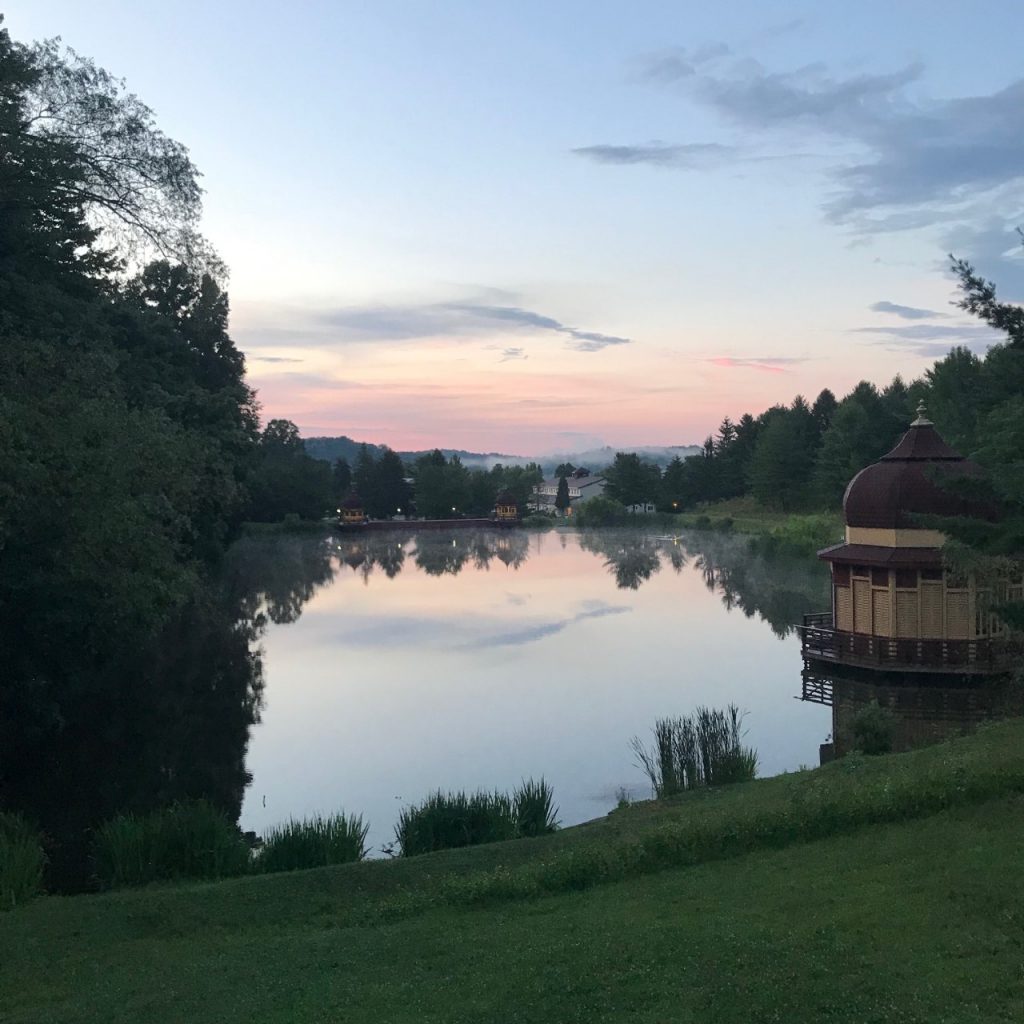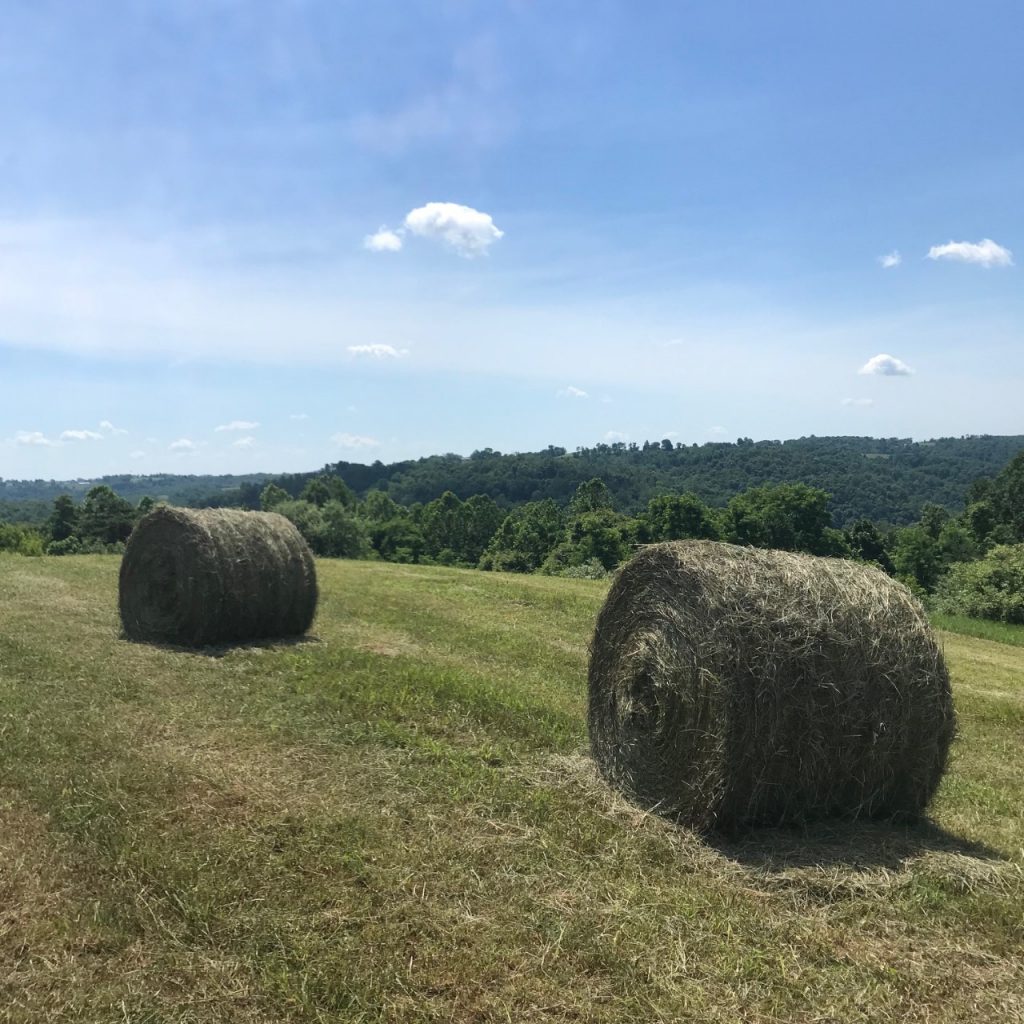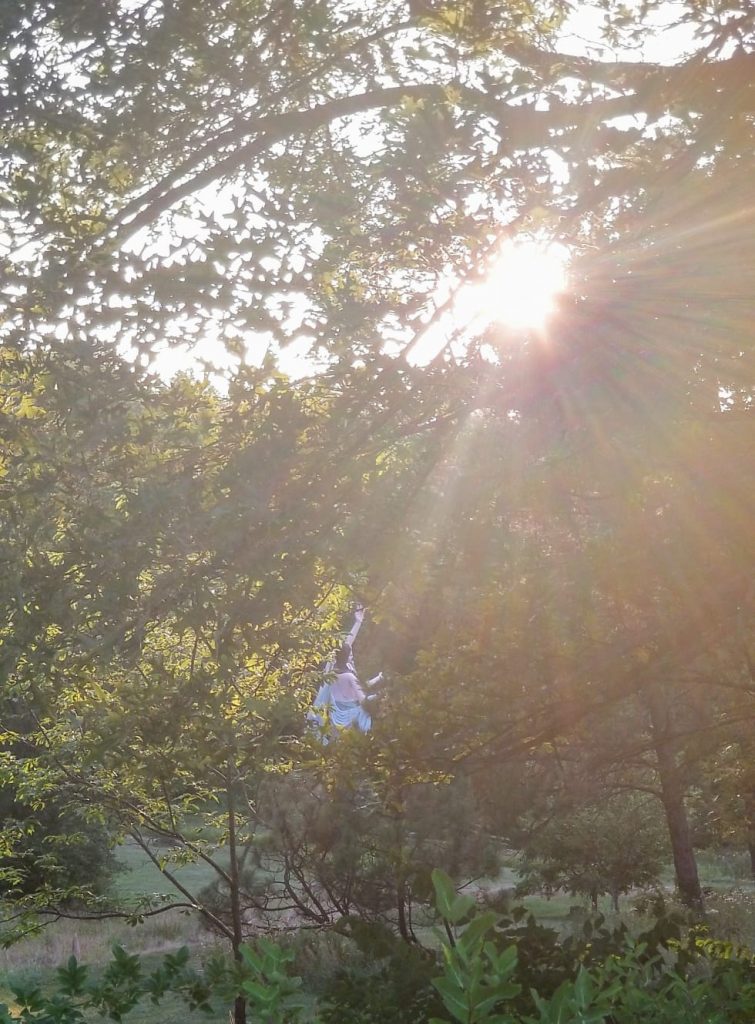I lived in a small community outside Wheeling, West Virginia for seven months in 2020. New Vrindaban – a spiritual community drawing on Vaisnava Hindu tradition, current population 100 people and 70 cows – was my refuge from COVID-19; a chance to turn inward, to connect with nature. And as a native New Yorker and certified East Coast Liberal, living in northern West Virginia amidst fracking wells, coal mines, and cow pastures was also my education.

* * *
It’s generally peaceful here in the hills of northern West Virginia, here in New Vrindaban Dham. Not much has changed in the last 50 years since its founding. In the morning, birds sing with the sunrise. Mist rises off the lake. The fragrance of hay, freshly scattered in mangers, drifts through the air. During the day, puffy clouds drift through the blue sky overhead. Cows moo and belch. People go to work. People come home. As dusk falls, the sound of crickets fills the air. The cows gather around their hay-pile to bed down, leaning comfortably on one another. Birds roost in the trees. People park their cars and pickup trucks. Lights go out one by one. Stars shine.
My life here, too, is generally peaceful. I rise early, before dawn, to meditate. I walk to the temple as the sun rises for community prayer. We sing and we dance in gratitude and praise. We read scripture. We eat breakfast. We joke and tease. During the day, I sit bent over my books, studying. Sometimes I work in the garden. I’m not sure whether bending over tomatoes or books makes my back hurt more, but I’m glad for the sunshine. In the evening, I return to the temple to hear young boys and girls singing sweet songs for the Lord. It soothes my heart. I walk home filled with peace.
One hot day in July, the convoys arrived. Convoys of trucks began rumbling down the steep one-lane road that winds through our community, air brakes blaring. Six trucks deep, they rolled through day and night. No matter where I was, I could hear the sound of their engines and their brakes cutting through the quiet air, echoing off the lake. Their mechanical noise was a jarring contrast to the songs of birds and the breeze. It made my shoulders tense.
Some were tankers, labeled “not for drinking.” Some had strange cubes on trailers, labeled “Halliburton.” The Halliburton boxes made chills run down my spine. Images of Halliburton trucks rumbling through Iraq flashed into my mind. Nationbuilding – here, too?
These were fracking trucks. The tankers were fracking wastewater. The cubes were full of sand, injected fractured earth to force out natural gas. The earth. Our Earth.
These convoys had come through before, I learned. For the last few years, every so often, for five or six weeks, convoys of trucks rolled through day and night, transporting toxic waste to and from God-knows-where after breaking apart our sacred earth.
New Vrindaban is not an ordinary place. Its presence here invokes that of Sri Vrindaban Dham, a holy place of pilgrimage, existing both in heaven and on Earth. Fifty years of prayerful, simple, ecological living have brought its spiritual energy here, to New Vrindaban. Even though residents don’t live as simply now as they did in those early days, the gardens and the cows and the thousand-acre woods keep the community’s spiritual-ecological vision alive.
Yet fracking is happening here in New Vrindaban. Coal, too; two summers ago, the coal came through, creating big cracks in the road and in everyone’s basements. The coal shifted the entire geology, choking the springs that brought water to the top of the hills and sending it back down to the bottom. The springs ran dry, the streams in the hollers nearly empty. The coal company paid for the roads and the basements and the water, too, but the cracks are still there in the earth.

* * *
While coal and natural gas have been tapped in the region since the early 20th century, the onset of fracking twenty years ago changed everything. Coal and gas expanded beyond Benwood and Cameron, where they were easy to access with the technology of the time. Now, fracking sites are visible from every ridge, sitting incongruously in the forest.
Fracking is not a compact industry. It requires a great deal of infrastructure, only some of which is visible above-ground. Every fracking project needs its drill rigs and its wells, of course. It needs pipelines – miles and miles of pipeline, buried underground in the hundred-foot-wide “land scars” that crisscross these forests. It needs containment tanks to store waste materials. It needs access roads and truck depots and mechanics. It needs a construction industry to build all of this. You can tell which families have benefited from the jobs and leases brought by the fracking boom just by driving down the road and seeing the renovated homes and new cars next door to run-down trailers and abandoned farmhouses. Fracking not only changed the material landscape; it also changed the financial one.
I still find it jarring when I round a bend in the road to encounter a fracking site, jumping out like an attraction in some haunted theme park. After six months here I’m still not used to it. And I know why. I expect my bucolic drives to remain bucolic because I am from New England. I am from a privileged landscape, where the country is country, towns are towns, and ugly industry is somewhere else. If I chose to, I could live a comfortable life there ignorant of the alchemy that powers it.
But, of course, what powers that lifestyle if not industry? New England’s era of timber and coal was well over 100 years ago. The Berkshires were mostly denuded then. It was a brutal industry. But the forests have regrown. You don’t see the damage unless you know what to look for. Thoreau and his contemporaries lamented the ugliness of the industrial sites that I now only know as quaint mills, historic railroads, and factories upgraded into museums.
My stomach turns when I see the marks of violence to the Earth. I am against it – a ridiculous statement. But neither do I want the tap turned off tomorrow. A cold-turkey approach to ending fossil fuels would bring untold suffering to millions. I suppose that even with fracking and coal, I’m a gradualist. Slow and steady. Enough time to plan for alternatives to our fossil fuel-addicted economy.
I have selfish reasons, too. I want the gas to put in my car to go home to New England. I want a comfortable life when I get there.

* * *
Back in New Vrindaban, I talk with our resident hermit-monk, Varsana Swami. He is an ecological sort of monk, living in a cabin off the grid. He worked with horses and mules for years. Varsana Swami says that our original broken connection is with God; our second is with Mother Earth; our third is with our own mothers. When I hear the fracking trucks and see the coal cracks, I feel broken. I wonder whether the tension in the community, deeply fractured under its peaceful surface, is due to the battle over fracking and coal a few years back. I wonder whether our nation’s despair over our future is due to our broken covenant with Earth.
Is this trinity of connections – trinity of brokenness – a causal chain? And if so, which is the original sin?
I brush the cows and I hear the trucks and I pray. Dear Lord. How have we come to this?
One day, the trucks stop. The air is quiet again. I breathe easier. Summer turns to fall and the quiet remains. Leaves rustle in the trees and fall to the ground, cloaking the forest with a golden carpet. Fracking – out of sight once more, out of mind.
The mornings become crisp again. I refill the heating oil in my cottage, check the gas in the car. If not for this daily dependency, I could almost forget my dependence on our broken Earth.
